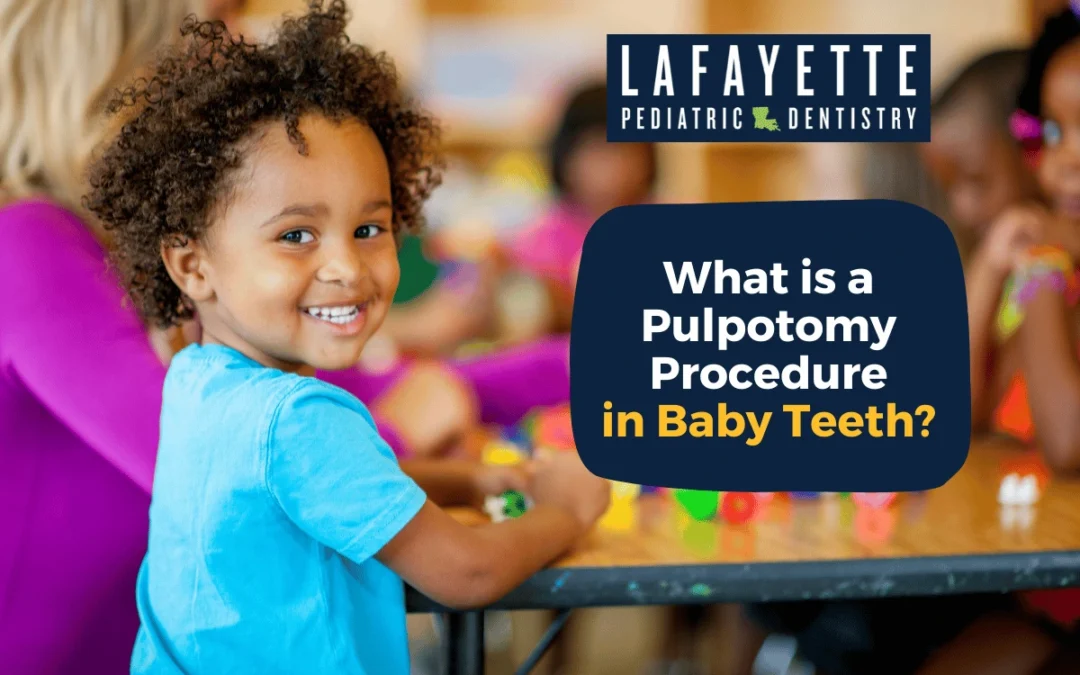Has your little one been complaining about tooth pain? Maybe you’ve already visited the dentist and heard them mention something about a ‘pulpotomy.’ Many parents aren’t familiar with this dental procedure, and it can definitely sound a little intimidating at first.
Baby teeth aren’t permanent, so parents may wonder why such procedures are necessary. After all, those teeth are going to fall out eventually, right? But there’s actually more to it than that.
Here’s what you should know about this dental procedure and why your dentist might recommend it for your child.
What’s a Pulpotomy?
A pulpotomy, also known as pulp therapy or a “baby root canal,” is a dental procedure that treats infected baby teeth.
The main goal of a pulpotomy is to preserve as much of the healthy tooth as possible instead of pulling it out. During the procedure, only the infected part of the pulp (the soft tissue inside the tooth that contains nerves and blood vessels) is removed. The healthy portion is left intact.
This is usually done when a baby tooth has been affected by tooth decay that’s reached the pulp in the crown but hasn’t yet spread to the roots.
When decay hits the pulp, it causes inflammation, and that’s when your child might start feeling pain, sensitivity to hot and cold, or trouble eating and sleeping.
Baby teeth actually have larger pulp chambers in proportion to the rest of the tooth compared to adult teeth. They also have much thinner enamel compared to adult teeth. Once tooth decay starts, it can spread REALLY fast if not stopped early.
That’s why pulpotomies are done: to stop the infection from spreading and avoid more invasive procedures like extractions. The goal is always to save the tooth if possible!
And fear not: while a pulpotomy sounds like a more extensive procedure than, say, a simple filling, your child’s tooth is numbed in the exact same way and should not feel discomfort for any of the procedure.
Why Do We Care So Much About Saving Baby Teeth?
Baby teeth are actually super important for more than just chewing. They help with proper speech development and hold space for the permanent teeth growing underneath. If a baby tooth is lost too early, it can mess with alignment and create a domino effect that might lead to more complicated orthodontic treatment later on.
However, there are so many factors at play when determining what type of treatment is recommended. Sometimes, even with our best efforts, a tooth just can’t be saved, and an extraction might be the better option to prevent an infection from spreading. Every child’s situation is different, and dentists always look at the big picture when deciding on the best treatment plan.
Read more: A Complete Guide to Primary Teeth Eruption
Steps You Can Take to Prevent a Pulpotomy
It can be disheartening to hear that your child needs a pulpotomy, and we totally get it because no parent wants to find out their child needs a more extensive dental procedure.
The best way to prevent this is by maintaining good oral hygiene at home and making regular dental visits. That means:
- Brushing twice a day with fluoride toothpaste
- Flossing once daily as soon as teeth start touching
- Limiting sugary snacks and drinks (especially sticky candies that stay on teeth for hours!)
- Scheduling regular dental check-ups every 6 months, starting when that first tooth pops up.
- Scheduling any needed dental work as soon as possible, to risk the chance of a small cavity (which would need a filling) from turning into a larger one that needs a pulpotomy and crown
Sometimes, cavities still happen despite our best efforts. Genetics can play a role in tooth development and enamel strength. Some kids just naturally have deeper grooves in their teeth where bacteria love to hide. And let’s be honest, some children are just really good at finding ways to avoid proper brushing!
Read more: Moving Past Parental Guilt When Your Child Has Cavities
If your child does need a pulpotomy, try not to feel guilty. We see this all the time, even in families with amazing oral hygiene habits. What matters most is catching the issue early and getting it treated promptly.
Conclusion
While procedures like pulpotomies might not be what you expected for your child’s baby teeth, they’re often the best way to keep your little one comfortable and protect their teeth.
If you have questions about pulpotomies or your child’s overall dental health, feel free to reach out to our team or book an appointment with us. As trusted pediatric dentists serving Lafayette, Breaux Bridge, Carencro, Youngsville, and the surrounding areas, we’re here to make dental care a positive, stress-free experience.
Making dental visits a good experience and giving your child the best possible care are our top priorities!
